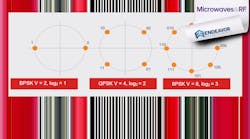This article appeared in Microwaves & RF and has been published here with permission.
What you’ll learn:
- A channel’s maximum throughput as a function of symbol rate and bandwidth.
- A channel’s maximum throughput as a function of noise interference.
- How throughput considerations go all the way back to the user.
It’s a very easy and normal thing to focus on the principal characteristics of the principal components of a communications system or link, and regard other items and issues as peripheral and not so important. That it has happened a surprising amount with satellite communications links, especially remote mobile ones, is the reason for this missive.
Here’s a hypothetical situation. You are a soldier. You’re deployed in a mountainous area of the Middle East, carrying an older Intelsat satellite terminal for immediate access back to headquarters, and the headquarters has leased a 72-MHz transponder for your exclusive use.
A nice, safe place to be is in a cave, so you string a communications cable to the satellite terminal at the cave’s entrance and sit back to check in with your workstation that’s connected to the terminal with a quadrature phase-shift keying (QPSK) modem. Checking in is fine, but the comm is lousy. The satellite company guarantees you 72 Mb/s (1 bit per Hz), but you’re barely getting less than 35 Mb/s. Should you have gotten a newer terminal? Should you be using another system?
Nyquist Maximum Data Rates
The actual answer is what Harry Nyquist and Claude Shannon said about maximum data rates over every channel, including that communications cable. Harry Nyquist noted, as has been thoroughly documented1, the maximum number of bits you can get through a channel (noise not considered) is:
Max R = 2 H Log2V
where H is the channel bandwidth and V is the number of discrete symbols (binary phase-shift keying, or BPSK, is 2, QPSK is 4, etc.).
If you’re not familiar with log2, it’s not difficult once you get used to it. The log2V is simply the exponent to which 2 must be raised to equal V. So, if V is BPSK (2), then the expression log2V is simply 1, since 21 is actually 2; and if V is QPSK (4), then the expression log2V is 2 since 22 is actually 4, and so on.
If you’re using a 10-MHz Cat 3 cable, then the maximum data rate INTO the satellite terminal is BPSK 20 Mb/s, QPSK 40 Mb/s, and 8PSK 30 Mb/s, as a function of the log2 relationships. Figure 1 shows the number of states and their log to the base 2 equivalent. Therefore, the Nyquist limit, using the QPSK modem, is 40 Mb/s.
Shannon Maximum Data Rates
Well, Harry Nyquist was working the issue of maximum data rates without considering noise while Claude Shannon was working it strictly as a function of noise. His equation2 says:
Max R = H log2 (1 + SNR)
where H is again the channel bandwidth and the SNR is the signal power divided by the noise power, generally given in dB. Let’s assume that the SNR on that same Cat 3 cable is around 30 dB or 1,000 in raw numbers (the SNR must be reconverted to its rational value to calculate an exponential). Since we’ve been running up the scale of 2’s exponentials, we can just continue to do that. Figure 2 shows that progression.
If we round off a bit for simplicity’s sake, 1,001 is closer to 1,024 than any other increment and 2 raised to the 10th power gives you a value far closer than any other exponent. Sitting back in your cave with a 10-MHz bandwidth Cat 3 cable, Claude Shannon says you should get a data rate of 10 x 106 (10) = 100 Mb/s.
If Claude Shannon says you can get a maximum data rate into the satellite communications terminal of 100 Mb/s and Harry Nyquist says you can only get 40 Mb/s to and from your QPSK-equipped workstation, who is right?
Let’s look at another analogy. The University of Notre Dame has an academically constrained but relatively good football team. On the other hand, it has a great marching band because outstanding musicians are frequently outstanding high-school students. To get onto the field, the band must march through two archways, one allowing 15 members abreast and one allowing 10. How many members abreast does the band form up? Well, in the same way, Nyquist and Shannon aren’t competing. They’re just two different gates with two different constraints.
It’s not just the major system. It’s the goes-intas and the goes-outas all the way to the hands typing on the keyboard. And the original papers published by physicist Nyquist3 and mathematician/engineer Shannon4 still have something to say to us.
References
1. An example of the equation can be found in any edition of Data and Computer Communications by William Stallings listed under Nyquist Bandwidth. Note: Different authors use different letters to designate data rate, bandwidth, etc.
2. As with Nyquist the equation being found in any edition of Data and Computer Communications by William Stallings, this one is listed under Shannon Capacity Formula. Note: Different authors use different letters to designate data rate, bandwidth, etc.
3. Certain topics in telegraph transmission theory (which implied the limit) were presented at the Winter Convention of the AIEE, New York, N.Y., February 13-17, 1928. It was republished as a “Classic Paper” in the Proceedings of the IEEE in February 2002.
4. “Communications in the Presence of Noise” was published in the Proceedings of the IRE in January 1949, nine years after it was written.


